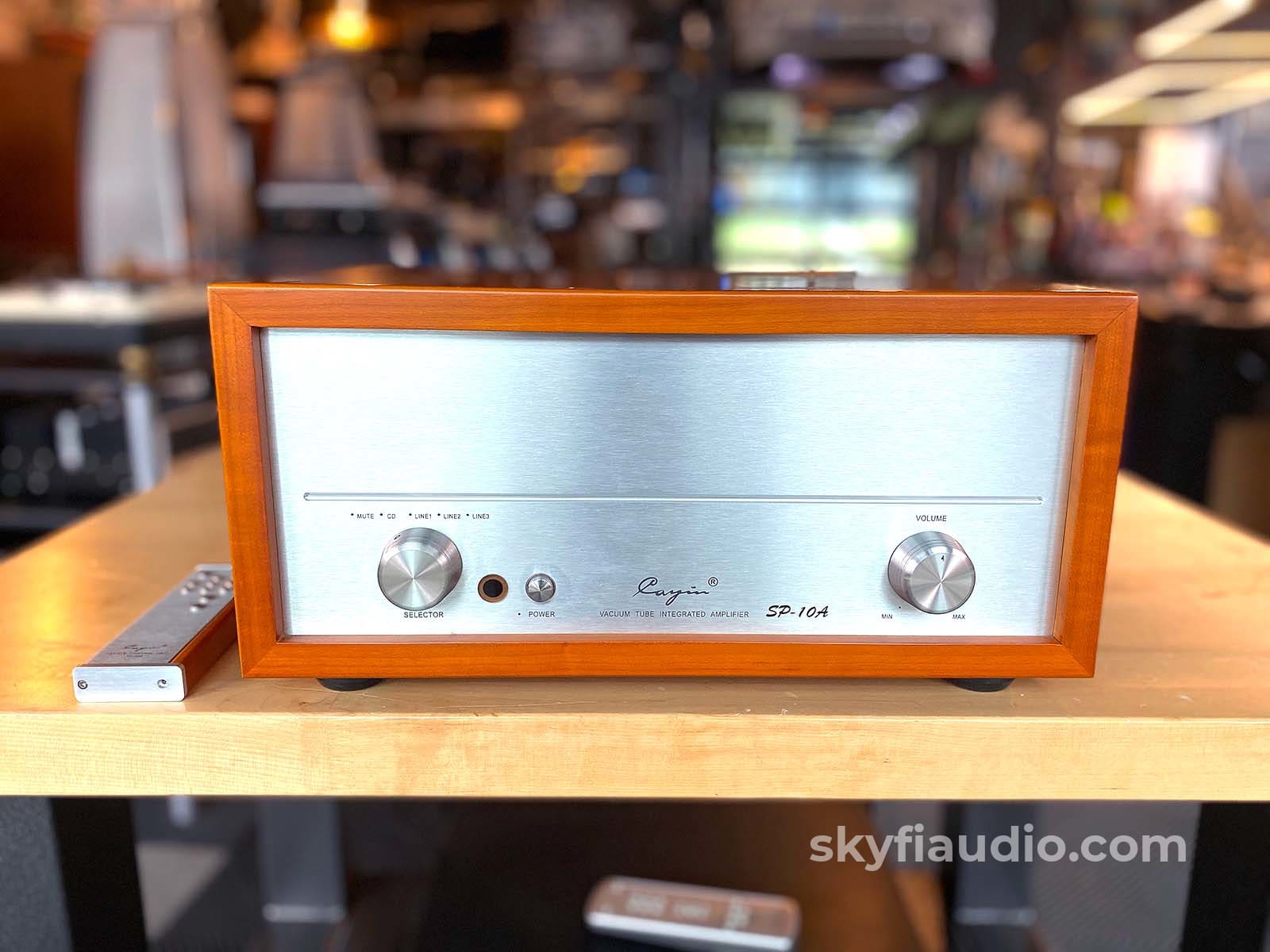
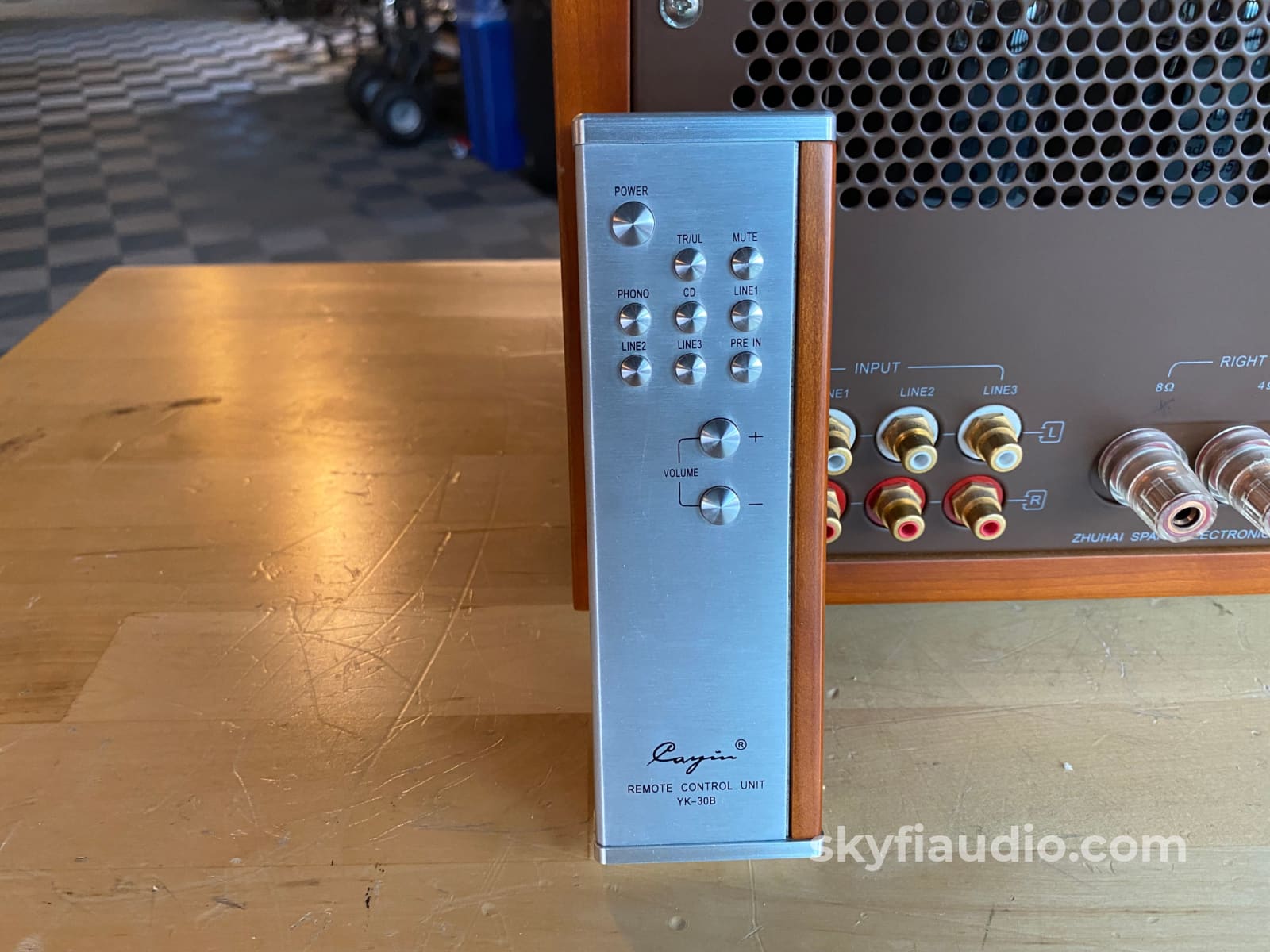
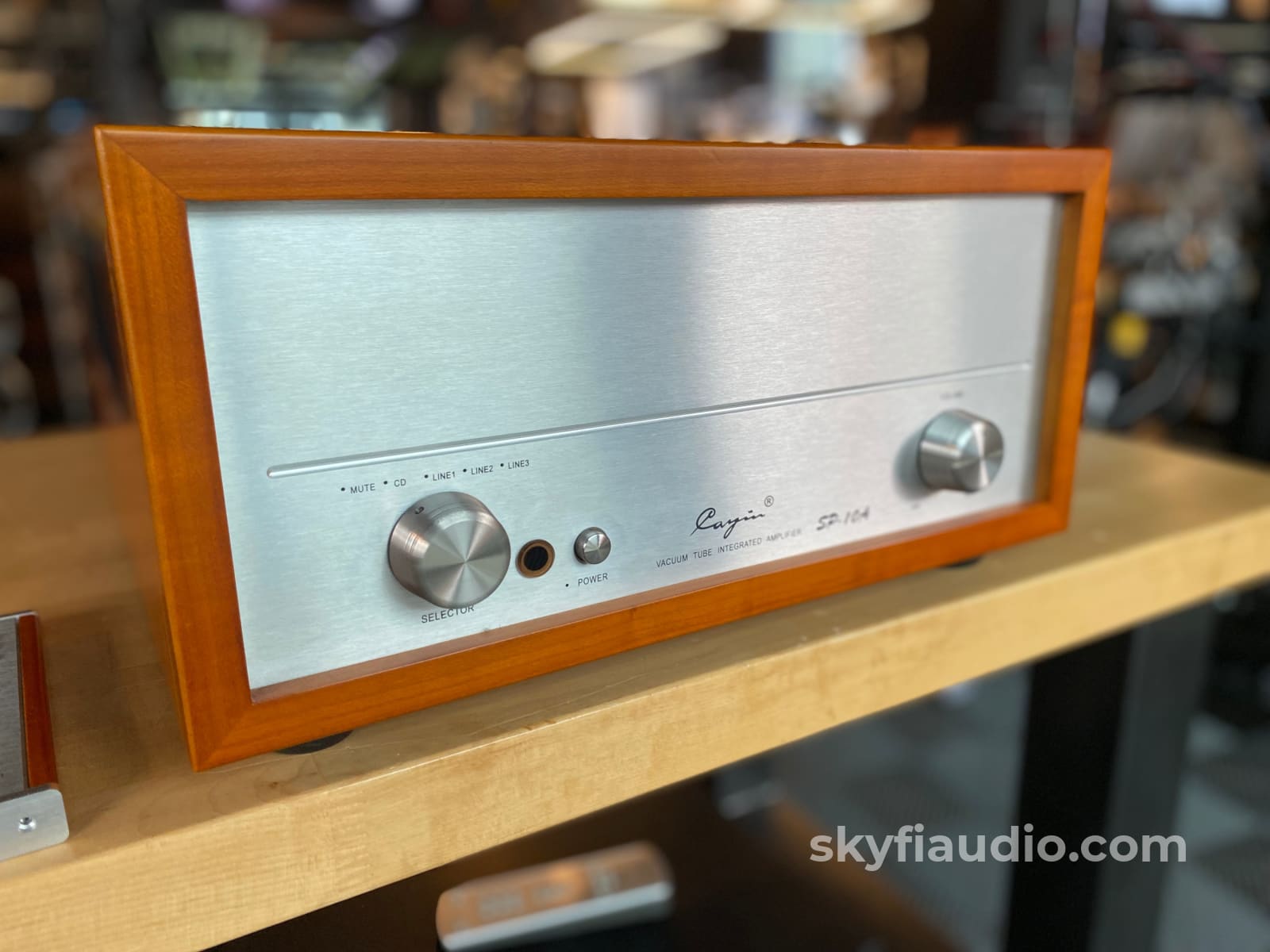
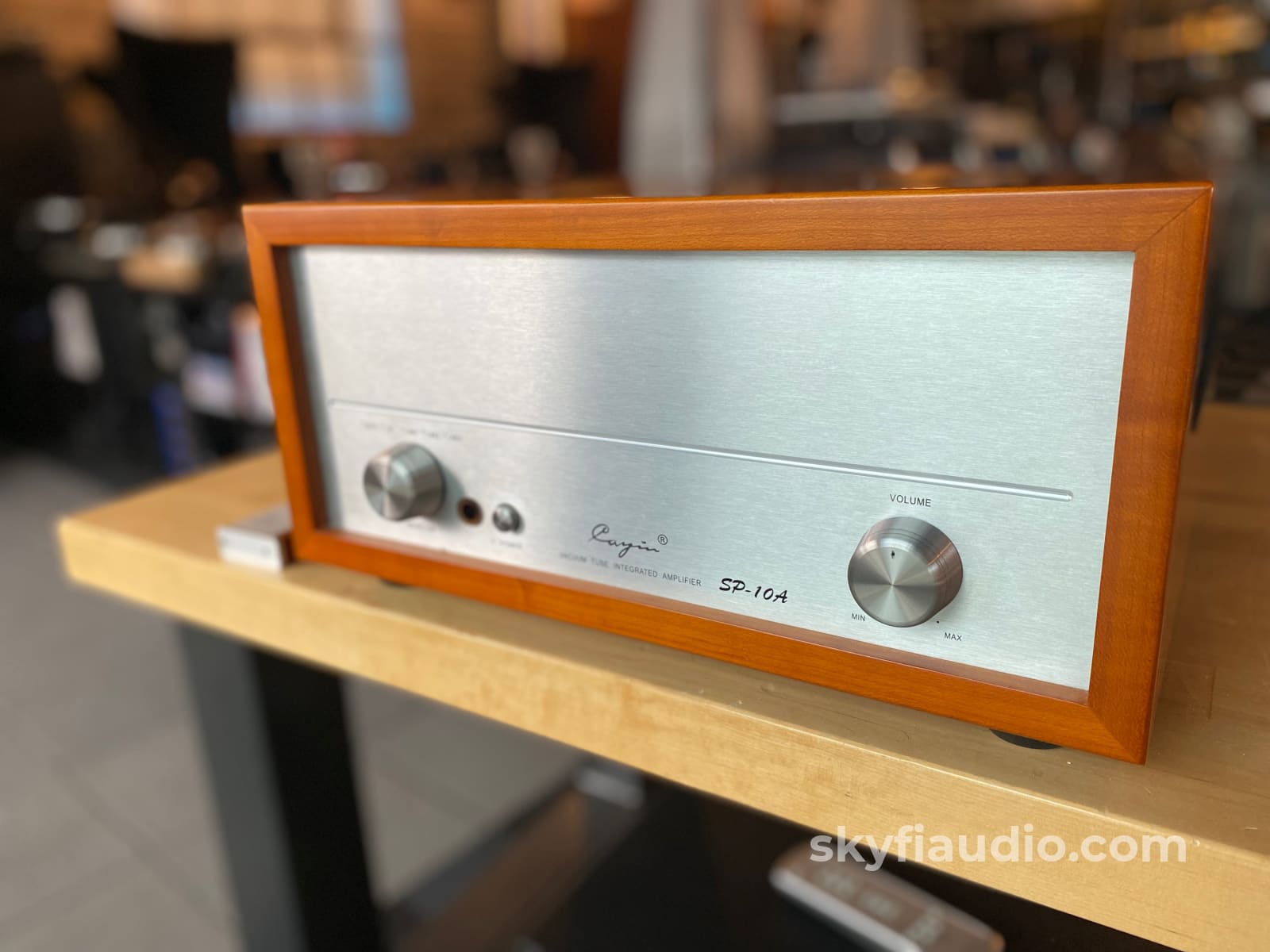
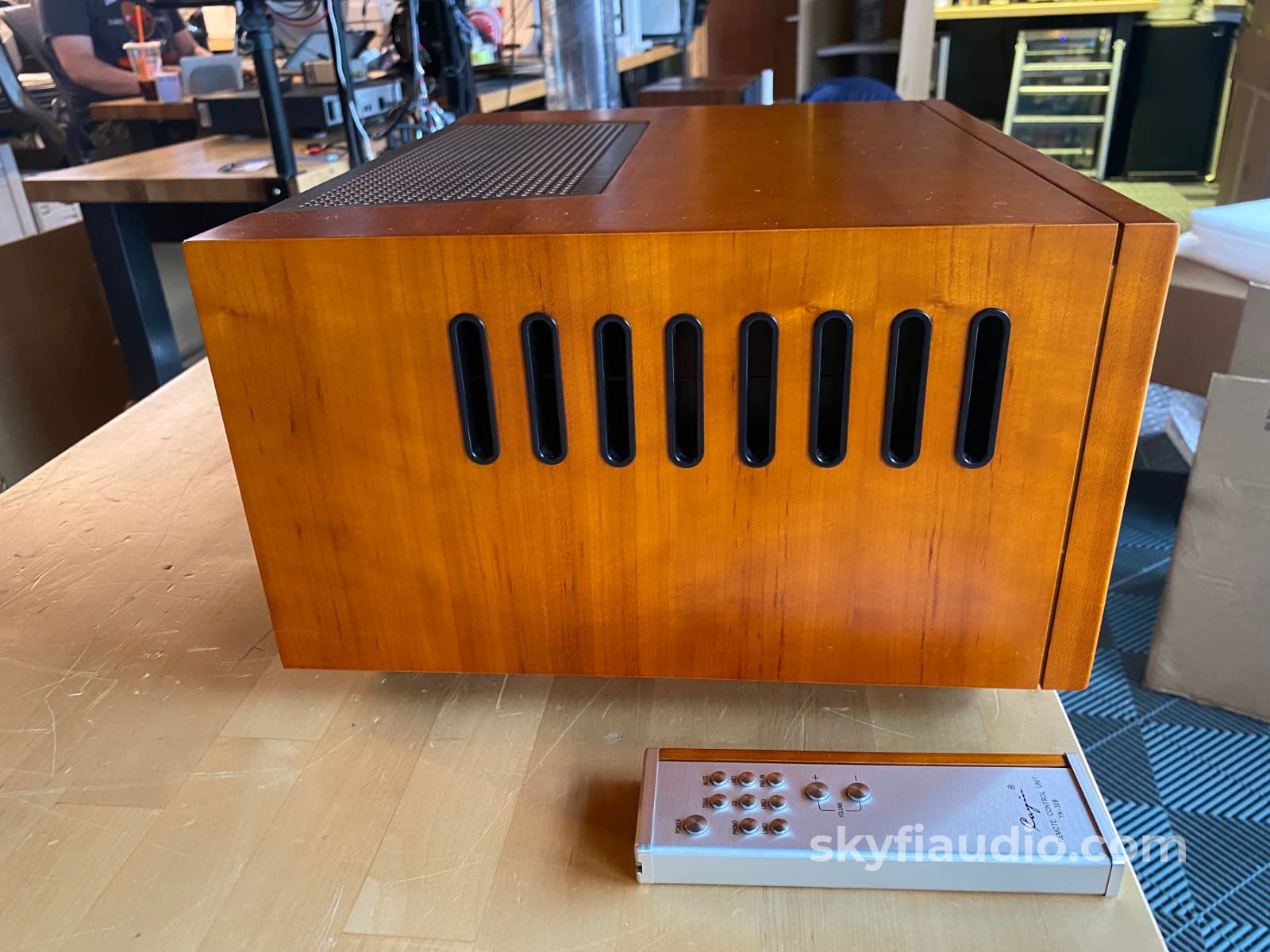
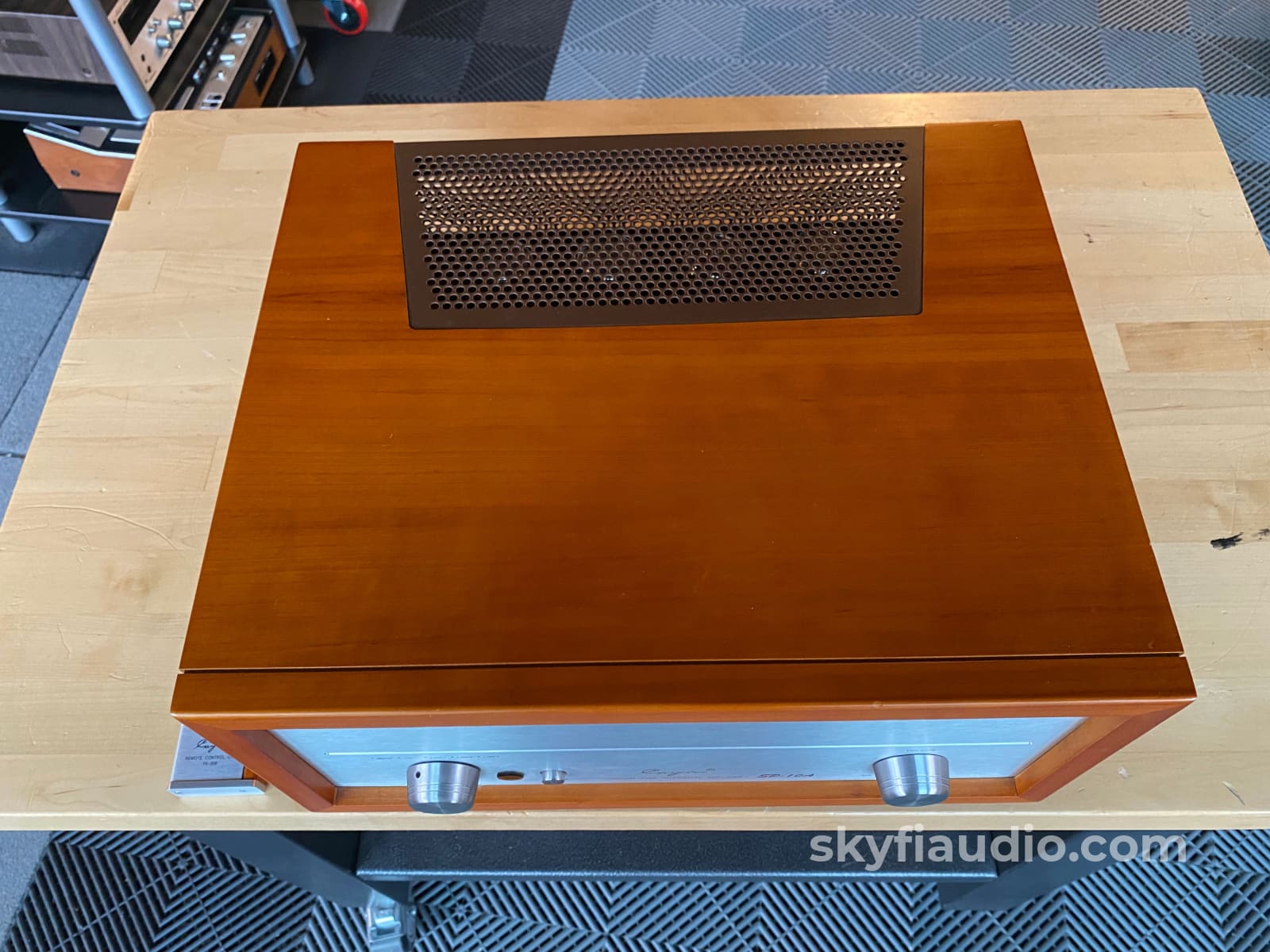
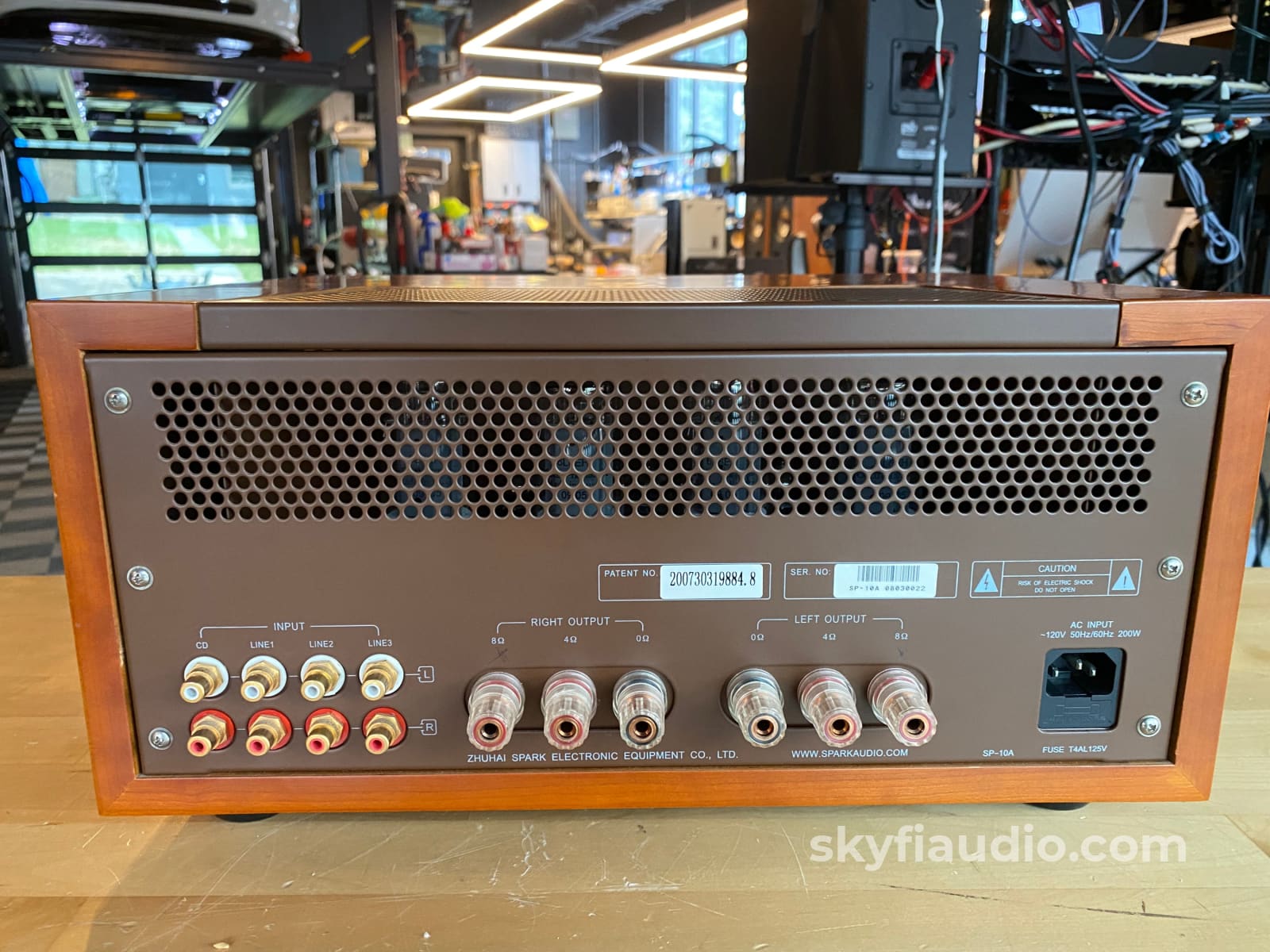
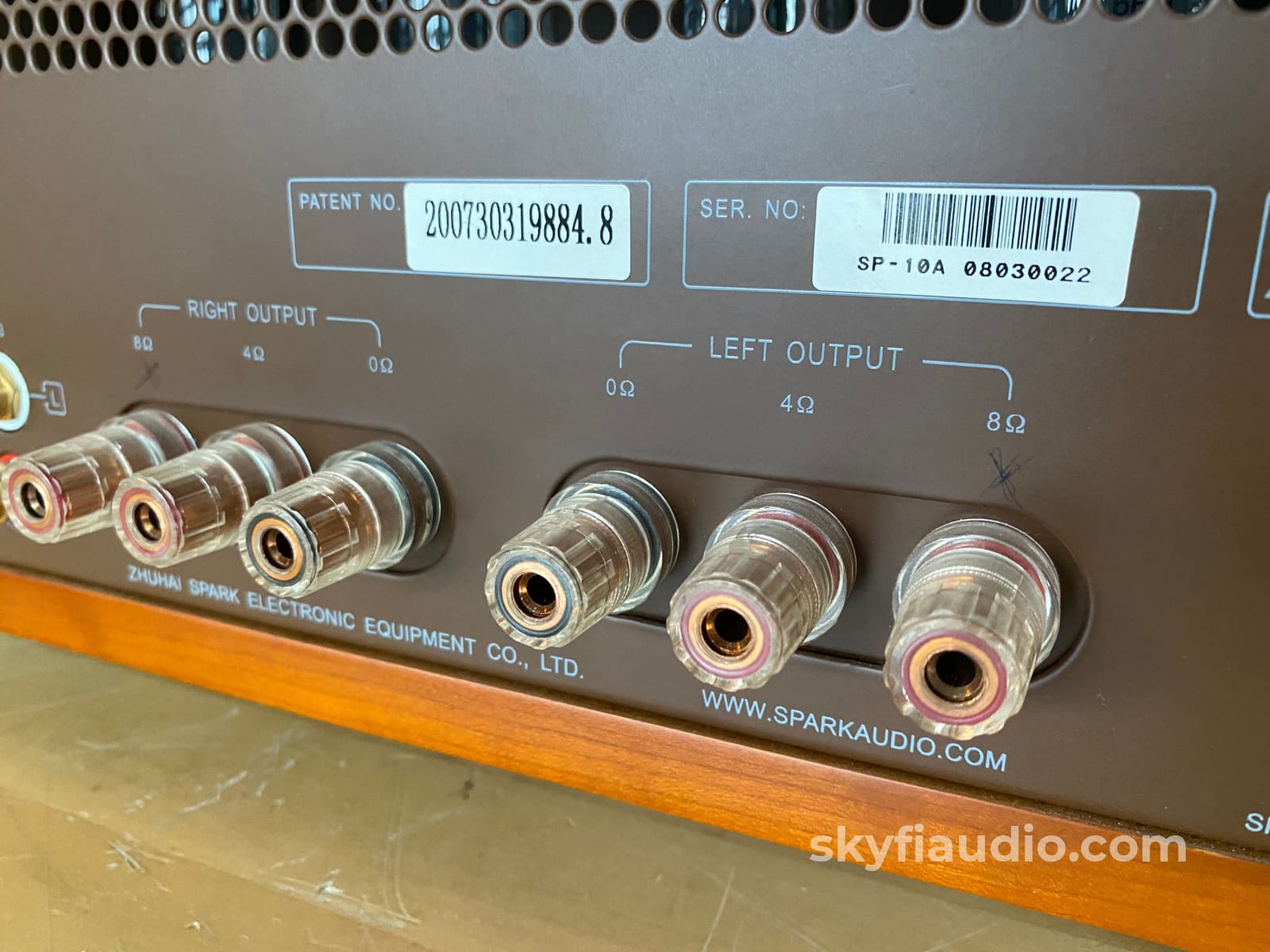
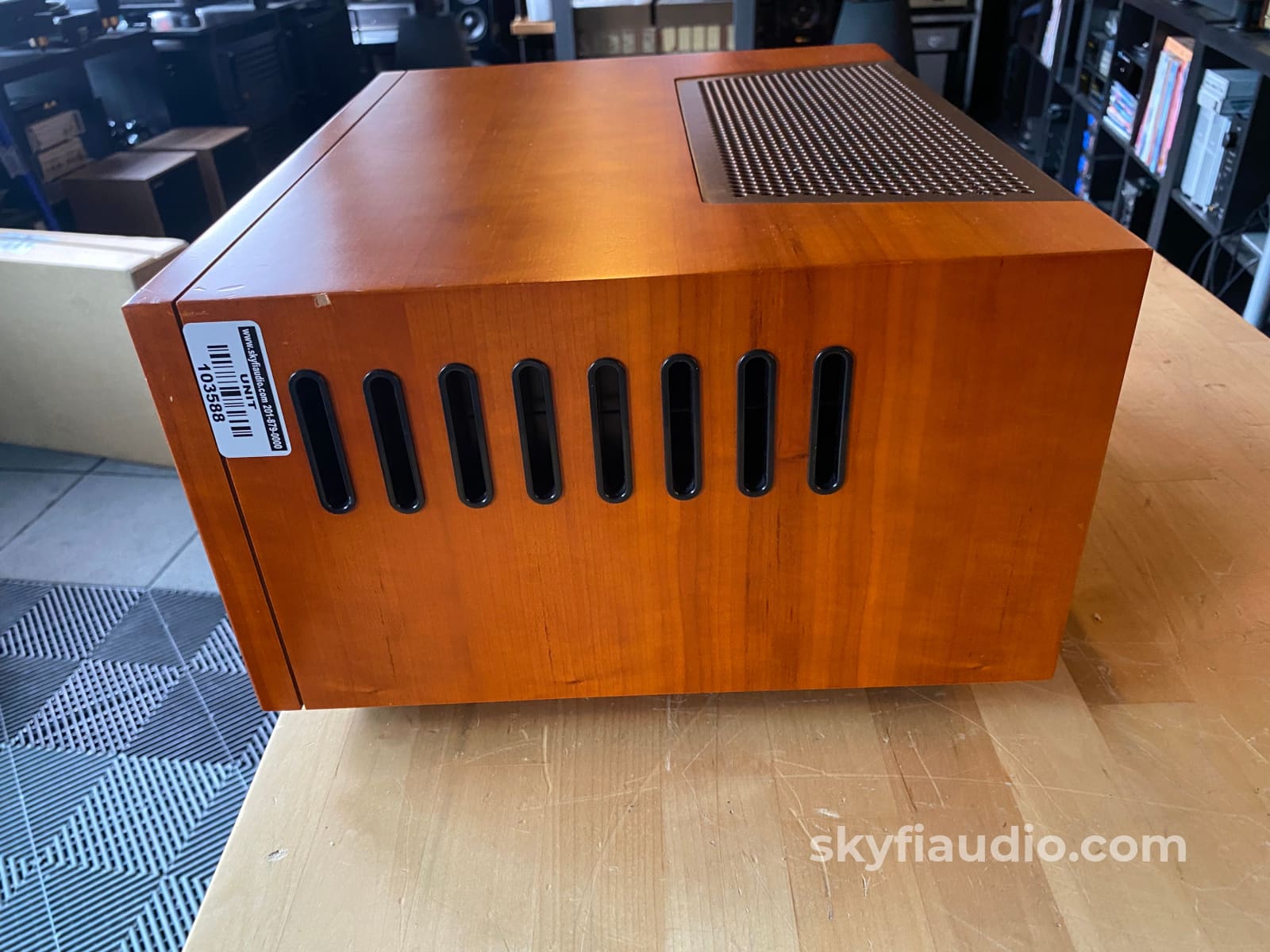
Cayin SP-10A Integrated Tube Amp with Remote
Free Shipping on Most Electronics - Excludes Speakers and Items Requiring Freight - Contiguous U.S. Only
Pickup currently unavailable at SkyFi 479

Cayin SP-10A Integrated Tube Amp with Remote
SkyFi 479
479 South Broad Street
Glen Rock NJ 07452
United States
Great performing tube integrated that's also good looking. Even the remote is stylish!
Tested and putting out the proper wattage in our shop and performing just like it should. Tubes show plenty of life left.
Very clean with little to no signs of use.
Cool power-off feature from the remote - when you hit power off the button on the integrated actually physically turns off from the front panel by pushing outward!
(This cool feature is designed to only work in the off position meaning the button on the unit does not push in on power on).
Click below to add our recommended matching cables from Kimber Kable, all brand new as SkyFi is an official Kimber dealer.
Kimber Kable - RCA Interconnects - Better
Kimber Kable - RCA Interconnects - Best
Kimber Kable - Speaker Cables - Good
Kimber Kable - Speaker Cables - Better
Kimber Kable - Bi-Wire Speaker Cables - Best
Kimber Kable - Power Cords - Good
Kimber Kable - Power Cords - Better
Kimber Kable - 14AWG (Gauge) Power Cords - Best
From a 2012 Stereophile review by Robert J. Reina:
When Steve Leung, of importer Valve Audio System (VAS) Industries, commissioned the design and manufacture of the SP-10A, he was driven by his love of the sound of the 6L6GC output tubes in his vintage McIntosh MC-240. Leung believes that the smooth, fluid midrange character of the 6L6GC power tube is superior to that of either the EL34 or KT88 tubes, and that this makes it a better choice for recordings of vocal music. The 6L6GC also "feels more powerful" to Leung, which leads him to think it better supports an amplifier driving difficult speaker loads. In addition to the four 6L6GCs, the SP-10A also has one 12AU7 phase splitter/driver tube per channel, and one 12AX7 input tube, which is shared between channels. The amp, which is wired point to point, has four line-level single-ended inputs, and both 4 and 8 ohm speaker outputs. The minimalist remote control has buttons for input selection, volume, and mute.
The SP-10A is a stunning piece of artistic machinery. Its faceplate of brushed aluminum fronts a cabinet of gorgeous cherrywood (walnut and piano lacquer are also available), which made it a natural visual match for the Epos M5i bookshelf speakers I used for the test, driving the speakers from the Cayin's 4 ohm output transformer tap. Not only did the cherry finishes match precisely, I'd swear that the high-quality wood used for all three cabinets was cut from the same tree.
The Cayin is not only solidly built; by a wide margin, it's the densest component I've reviewed in 25 years: an integrated amp weighing 44 lbs but measuring only 16" wide by 8" high by 13" deep
I compared the SP-10A ($2195) with my current reference integrated amplifier, a Creek Destiny ($2395) . Each was a very neutral performer with a warm, inviting midrange. However, their overall presentations of texture in the midrange, particularly of voices, differed a bit. The Cayin seemed to bathe voices in a golden glow, while the Creek enveloped them in a silvery sheen. The Cayin resolved a significantly greater amount of detail and ambience in the midrange (though the Creek was still excellent in this regard), and reproduced a linear, low-level dynamic envelope from pppp to p even better than the Creek did. But the Destiny was far superior in its rendering of high-level dynamics.
The Creek's high frequencies were more extended but less airy than the Cayin's, but both amps' overall timbral presentations were quite natural. Their reproductions of the midbass were equally natural, though I felt the Creek was capable of a bit more bottom-end slam. Each amp's reproduction of transients was very fast and natural, but again, with different textures. The Cayin's transients seemed a bit softer and more delicate, while the Creek presented slightly sharper envelopes.
Cayin has created another winner with the SP-10A—a neutral, detailed, and involving integrated amplifier that performs at a level higher than one would expect for the price. And that cherry cabinet is dead gorgeous.
Specifications and Details:
Tube complement:
1 x 12AX7
2 x 12AU7
4 x 6L6GC
Power output:
38 WPC
(15.8dBW)
Frequency range:
15 Hz – 35 kHz
Total harmonic distortion:
<1% at 1kHz
Signal/noise ratio:
85dB
Input sensitivity:
470mV
Input impedance:
100k ohms
Output impedances:
4, 8 ohms
Maximum power consumption:
200W
Dimensions:
16" (410mm) W
8" (205mm) H
13" (330mm) D
Weight:
44 lbs
(20kg)
Finishes:
Cherry, Walnut, Piano Black
The SkyFi Testing Process for Tube Amplifiers:
We start with a visual inspection of all internal components to make sure that there are no signs of heat stress or damage. Capacitors are checked for telltale signs of predictive failure including bulging, shrunken wrappers, or physical leakage. We also inspect resistors and other passive components for signs of overheating. If tube arcing has occurred in the past we can usually spot discoloration on the output tube sockets. On vintage units we often spot check select capacitors for value and ESR.
If the amplifier passes visual inspection, we move on to a full test of all of the tubes. We use an Amplitrex AT-1000 Tube Tester which is capable of testing both emission and Gm with a high degree of accuracy. We document the results of each tube and replace any weak or suspect tubes before proceeding. When we power on tube amplifiers for the first time we usually use a variac and current limited AC supply and slowly raise the voltage up to nominal mains level while monitoring plate, screen, filament, and negative bias supply voltages where applicable. If everything is in order we feed a low level test signal into the amplifier’s input and monitor its output on an oscilloscope across an 8 ohm dummy load. At this point we are just looking to verify basic function and confirm that the output transformers are not damaged. Once we have verified that the amplifier is safe to operate, we connected it to full mains power. For fixed bias amps we set the bias to manufacturer spec. For cathode biased amps we monitor the plate to cathode voltage to determine if the output tubes are operating in a safe range. Once the output section is verified we move onto bench evaluation.
We start by feeding the input of the amplifier with a low level 1KHz test signal, slowly increase its amplitude while monitoring the amplifier’s output on an oscilloscope for signs of noise, clipping, distortion, or improper channel balance. We continue increasing the signal level until the amplifier reaches clipping. At this point we take an output power measurement and compare it to the spec sheet of the amplifier to verify proper performance. We finish off the bench evaluation with a 1KHz square wave check and a 20Hz to 20KHz sine sweep to assess the amplifier’s frequency response characteristics. This battery of tests will usually reveal if the amplifier has any issues that need further attention.
Before the device leaves the bench, we perform a listening test with actual music using a variety of preferred test tracks. Our benches are outfitted with familiar monitor speakers which help us identify inconsistencies that will not always show up on our test gear. The main things that we are listening for are hum or noise with no signal present, proper center image, clicks, pops, or any other obvious undesirable audio characteristics.
If the unit passes all of these tests it is moved to our long term testing rig where we simulate real word operating conditions for 6-8 hours. For tube amps we like to run this test at least twice. This allows us to monitor the unit for signs of thermal runaway or intermittent issues that only crop up when it has fully come up to temperature. We find this step to be essential, especially for vintage units.
|
Item |
Included |
|
Original Box |
Not Included |
|
Manual |
Not Included |
|
Remote |
Yes Included |
|
Cables |
Yes - Power Only |
|
Physical Condition |
8 / 10 |
|
Working Condition |
10 / 10 |
Choose options









